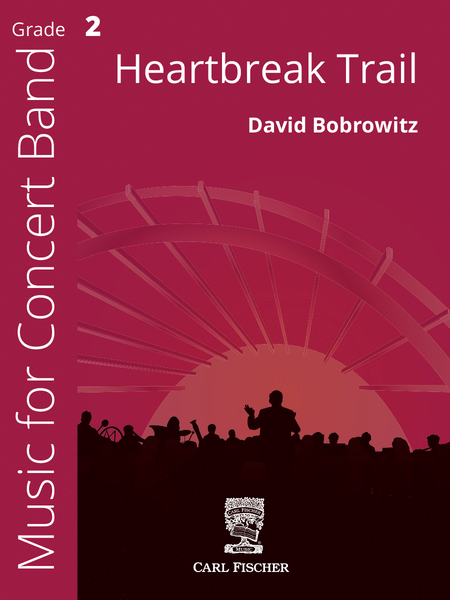Details
Description
SKU: CF.YPS241
Composed by David Bobrowitz. Set of Score and Parts. 17+4+4+2+4+4+2+2+3+2+2+2+4+4+4+4+3+3+3+2+3+2+1+3+3 pages. Duration 2 minutes, 53 seconds. Carl Fischer Music #YPS241. Published by Carl Fischer Music (CF.YPS241).ISBN 9781491159651. UPC: 680160918249.
PROGRAM NOTES Heartbreak Trail describes the forced relocation of approximately 100,000 Native Americans in the 1830s. Known as the Trail of Tears, thousands lost their lives during the march, and it is remembered today as a great human-rights atrocity and a shameful period in American history. The opening A-section captures the sadness of those in the five tribes who were forced from their homeland. The fast B-section represents the determination to survive the long, difficult trek. Although there were many obstacles, thousands did survive, but a dark A-section returns to depict the loss of homeland, fellow tribe members, and a depression over the new lack of freedom. PERFORMANCE NOTES The opening should be at a moderate pace and section entrances should be balanced at mezzo piano. In m. 12 have the woodwinds play out their melodic material. In m. 20 the brass should pick up the same volume level as did the woodwinds previously. Measure 27 should die away from what was, and then a sudden change in volume, and mood at m. 31. The entire B-section should be bold, with attention paid to the many accents. (Before working the B-section, an explanation of the difference in accents will probably aid in accuracy.) Measures 37 and 41 have the timpanist and tom-tom player play a very strong forte with attention to the accents. Measures 51 to 52 work a strong quick crescendo to fortissimo. This should set up the tutti forte at m. 53. In m. 61 start a gradual diminuendo to the return of the A-section at m. 68. Explain how to execute the staggered breathing for the flutes, tenor sax and trombone starting at m. 73. Although the final percussion from m. 73 to the end is soft and fading, make sure the final sleigh bell sounds are heard clearly.
PROGRAM NOTESHeartbreak Trail describes the forced relocation of approximately 100,000 Native Americans in the 1830s. Known as the Trail of Tears, thousands lost their lives during the march, and it is remembered today as a great human-rights atrocity and a shameful period in American history. The opening A-section captures the sadness of those in the five tribes who were forced from their homeland. The fast B-section represents the determination to survive the long, difficult trek.Although there were many obstacles, thousands did survive, but a dark A-section returns to depict the loss of homeland, fellow tribe members, and a depression over the new lack of freedom.PERFORMANCE NOTESThe opening should be at a moderate pace and section entrances should be balanced at mezzo piano. In m. 12 have the woodwinds play out their melodic material. In m. 20 the brass should pick up the same volume level as did the woodwinds previously. Measure 27 should die away from what was, and then a sudden change in volume, and mood at m. 31. The entire B-section should be bold, with attention paid to the many accents. (Before working the B-section, an explanation of the difference in accents will probably aid in accuracy.) Measures 37 and 41 have the timpanist and tom-tom player play a very strong forte with attention to the accents. Measures 51 to 52 work a strong quick crescendo to fortissimo. This should set up the tutti forte at m. 53. In m. 61 start a gradual diminuendo to the return of the A-section at m. 68. Explain how to execute the staggered breathing for the flutes, tenor sax and trombone starting at m. 73. Although the final percussion from m. 73 to the end is soft and fading, make sure the final sleigh bell sounds are heard clearly.

 Share
Share